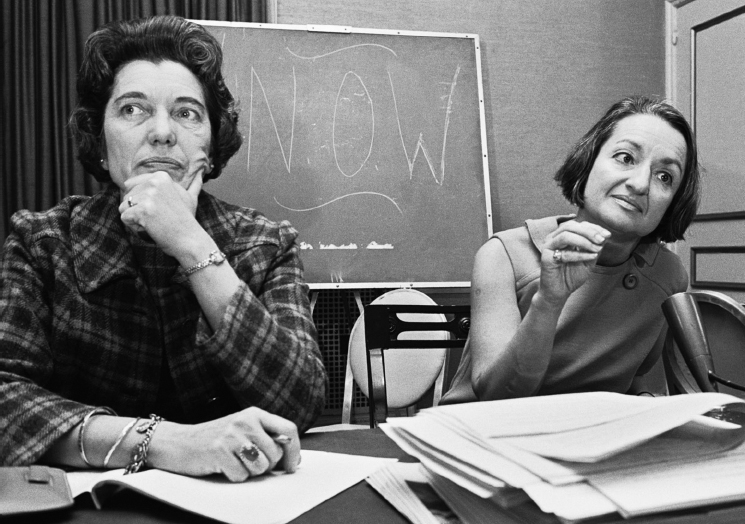America’s History: Printed Page 908
America: A Concise History: Printed Page 824
America’s History: Value Edition: Printed Page 803
Rebirth of the Women’s Movement
The new era of liberal reform reawakened the American women’s movement. Inspired by the civil rights movement and legislative advances under the Great Society, but frustrated by the lack of attention both gave to women, feminists entered the political fray and demanded not simply inclusion, but a rethinking of national priorities.
Labor Feminists The women’s movement had not languished entirely in the postwar years. Feminist concerns were kept alive in the 1950s and early 1960s by working women, who campaigned for such things as maternity leave and equal pay for equal work. One historian has called these women “labor feminists,” because they belonged to unions and fought for equality and dignity in the workplace. “It became apparent to me why so many employers could legally discriminate against women — because it was written right into the law,” said one female labor activist. Trade union women were especially critical in pushing for, and winning, congressional passage of the 1963 Equal Pay Act, which established the principle of equal pay for equal work.
Labor feminists were responding to the times. More women — including married women (40 percent by 1970) and mothers with young children (30 percent by 1970) — were working outside the home than ever before. But they faced a labor market that undervalued their contributions. Moreover, most working women faced the “double day”: they were expected to earn a paycheck and then return home to domestic labor. One woman put the problem succinctly: “The working mother has no ‘wife’ to care for her children.”

Betty Friedan and the National Organization for Women When Betty Friedan’s indictment of suburban domesticity, The Feminine Mystique, appeared in 1963, it targeted a different audience: college-educated, middle-class women who found themselves not working for wages but rather stifled by their domestic routine. Tens of thousands of women read Friedan’s book and thought, “She’s talking about me.” The Feminine Mystique became a runaway best-seller. Friedan persuaded middle-class women that they needed more than the convenience foods, improved diapers, and better laundry detergents that magazines and television urged them to buy. To live rich and fulfilling lives, they needed education and work outside the home.
Paradoxically, the domesticity described in The Feminine Mystique was already crumbling. After the postwar baby boom, women were again having fewer children, aided now by the birth control pill, first marketed in 1960. And as states liberalized divorce laws, more women were divorcing. Educational levels were also rising: by 1970, women made up 42 percent of the college population. All of these changes undermined traditional gender roles and enabled many women to embrace The Feminine Mystique’s liberating prescriptions.
Government action also made a difference. In 1961, Kennedy appointed the Presidential Commission on the Status of Women, which issued a 1963 report documenting job and educational discrimination. A bigger breakthrough came when Congress added the word sex to the categories protected against discrimination in the Civil Rights Act of 1964. Women suddenly had a powerful legal tool for fighting sex discrimination.
To force compliance with the new act, Friedan and others, including many labor feminists from around the country, founded the National Organization for Women (NOW) in 1966. Modeled on the NAACP, NOW intended to be a civil rights organization for women, with the aim of bringing “women into full participation in … American society now, exercising all the privileges and responsibilities thereof in truly equal partnership with men.” Under Friedan’s leadership, membership grew to fifteen thousand by 1971, and NOW became, like the NAACP, a powerful voice for equal rights.
One of the ironies of the 1960s was the enormous strain that all of this liberal activism placed on the New Deal coalition. Faced with often competing demands from the civil rights movement, feminists, the poor, labor unions, conservative southern Democrats, the suburban middle class, and urban political machines, the old Rooseveltian coalition had begun to fray. Johnson hoped that the New Deal coalition was strong enough to negotiate competing demands among its own constituents while simultaneously resisting conservative attacks. In 1965, that still seemed possible. It would not remain so for long.
IDENTIFY CAUSES
Question
What factors accounted for the resurgence of feminism in the 1960s?